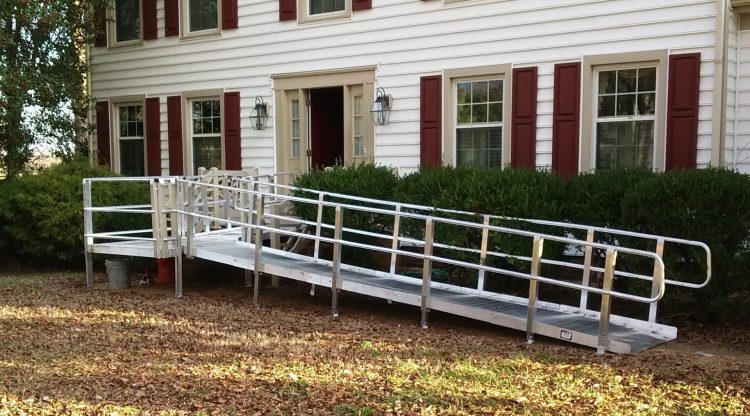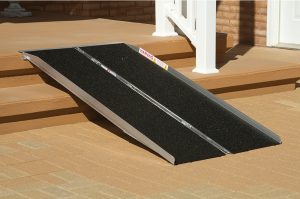
[originally published 2/23/15]
When it comes to accessibility or mobility related concerns, one of the first questions people tend to ask is “How am I going to get in and out of the house?” If you or someone you know haven’t ever asked this question, then consider yourself lucky. For those of you that have, maybe you have found a solution (hopefully you have). If not, we hope this information finds you. There are no limits to people’s creativity when it comes to getting around with limited mobility. We have seen everything (including the kitchen sink) used to make a wheelchair ramp. That is another story… This is true that you can use what you can find to make an accessible route. One thing to keep in mind is safety.
If you are not familiar with the ADA or Americans with Disabilities Act, you should be. They have set the standards for what is considered safe when it comes to ramp systems. The ADA does not regulate your personal ramp but you would be wise to follow their guidelines for safety. The main rule of thumb when it comes to ramps is a 1:12 pitch. For every inch high the ramp must go out 1 foot. For example, if you need to get up to your porch that is 23″ high, a safe ramp would be 23′ long. This can be quite a pricey request if you are trying to gut up very tall porches. There are many other rules and guidelines for a safe ramp written in the ADA Guidelines (Click for full details) but to keep this short and sweet that is the only one we will focus on.
If you have done any research online about wheelchair ramps etc… you may have found that the modular ramps can be quite expensive. This can be true. In most cases it will be cheaper to build a ramp out of wood. If this is the route you want to take please make some considerations before proceeding:
Make sure to address the traction of the wood when wet
Have the builder try to follow ADA Guidelines
Make sure the wood is treated lumber or painted to endure the elements
The hardware should be stainless, galvanizes, or outdoor rated
Consider what will happen if the ramp is no longer needed
An alternative to a stick built (wooden) ramp is a modular ramp. Again these can be more expensive than wooden in some cases but can be reused so you may be able to purchase used ramps or take advantage of some company’s ramp rental programs. Some of the benefits of a modular ramp system include:
Can be set up and broken down in a few hours
Lifetime warranty
Will not rot
Do not become slippery
Easily cleaned
Two different materials commonly used for modular ramps are steel and aluminum. Steel being a cheaper commodity is a cheaper ramp. This can be good for your wallet but may not have a song of a lifespan if not properly maintained. Steel can rust if not tended to so the recommendation is that these ramps be painted with a rust resistant paint annually. Aluminum on the other hand carries a bit higher price tag but will never rust and therefore there is no annual painting required.
Threshold Ramps
 A detail that commonly gets over looked is the threshold at the door. This can be a trip hazard for those that have trouble lifting their feet and a bit of a tough situation to those with a wheelchair, scooter, walker, or rollator. There are many different makes and styles of threshold ramps for you to explore. We ask that you explore them and not forget about the threshold. Rubber threshold ramps are very common and made from recycled tires (at least they get used for something). These are allowed to be a bit steeper by the ADA standards as they are only going up to 6″ max in the threshold ramp category. A 1:8 slope is that maximum the ADA recommends. These ramps can be ordered online and simply drop shipped to your location if you know the measurements of the doorway threshold. We are seeing more requests for threshold ramps with handrails (not required by the ADA) to help people get in and out of doorways. This can be extremely helpful for people with limited mobility that do not use a walking assistance device. If you are in this category, we encourage you to explore threshold ramps with handrails. If you are not sure what solution works best for you, contact Centerspan Medical 800-980-3718 for a free home evaluation.
A detail that commonly gets over looked is the threshold at the door. This can be a trip hazard for those that have trouble lifting their feet and a bit of a tough situation to those with a wheelchair, scooter, walker, or rollator. There are many different makes and styles of threshold ramps for you to explore. We ask that you explore them and not forget about the threshold. Rubber threshold ramps are very common and made from recycled tires (at least they get used for something). These are allowed to be a bit steeper by the ADA standards as they are only going up to 6″ max in the threshold ramp category. A 1:8 slope is that maximum the ADA recommends. These ramps can be ordered online and simply drop shipped to your location if you know the measurements of the doorway threshold. We are seeing more requests for threshold ramps with handrails (not required by the ADA) to help people get in and out of doorways. This can be extremely helpful for people with limited mobility that do not use a walking assistance device. If you are in this category, we encourage you to explore threshold ramps with handrails. If you are not sure what solution works best for you, contact Centerspan Medical 800-980-3718 for a free home evaluation.
Portable Ramps
 Portable ramps can be very helpful with temporary situations where the ramp is not needed all the time. If you are exploring a portable rampPLEASE DO NOT GET A RAMP THAT IS TOO STEEP! We see this too often where someone orders a portable ramp online and pays a lot of money to create a dangerous situation for the user and/ or caregiver. Remember the ADA guidelines and consider the rise before purchasing a portable ramp. Again these ramps can be helpful if you know what you are purchasing. Another consideration with these portable ramps is who will be moving the ramp? These ramps can weigh 30 or more pounds sometimes and be quite cumbersome to lug around and set up. The trifold ramps are the hardest to use. If the person moving the ramp is capable of lifting and folding/ un-folding, you are good to go! Portable ramps can sometimes be used to help loading mobility equipment into the back of a vehicle. This can be more cost effective than some auto lifts but make sure that you understand how much space the ramp will take up in the vehicle along with the mobility device.
Portable ramps can be very helpful with temporary situations where the ramp is not needed all the time. If you are exploring a portable rampPLEASE DO NOT GET A RAMP THAT IS TOO STEEP! We see this too often where someone orders a portable ramp online and pays a lot of money to create a dangerous situation for the user and/ or caregiver. Remember the ADA guidelines and consider the rise before purchasing a portable ramp. Again these ramps can be helpful if you know what you are purchasing. Another consideration with these portable ramps is who will be moving the ramp? These ramps can weigh 30 or more pounds sometimes and be quite cumbersome to lug around and set up. The trifold ramps are the hardest to use. If the person moving the ramp is capable of lifting and folding/ un-folding, you are good to go! Portable ramps can sometimes be used to help loading mobility equipment into the back of a vehicle. This can be more cost effective than some auto lifts but make sure that you understand how much space the ramp will take up in the vehicle along with the mobility device.
For more information about accessible ramps as well as any questions relating to mobility or accessibility please contact us at www.centerspanmedical.com 1-844-SAFE-STAIR (844-723-3782) or feel free to e-mail us info@centerspanmedical.com.
